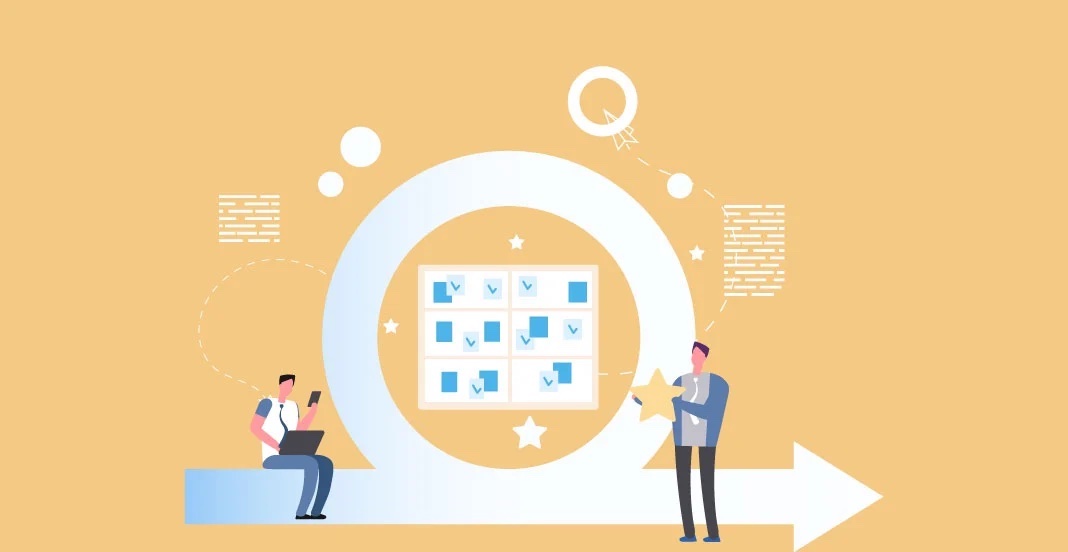
Leveraging Agile Methodologies for Effective Project Delivery
Delivering projects successfully is more critical than it has ever been in the fast-paced world of today. Businesses are continuously attempting to remain ahead of the competition, and projects that take too long or fail to deliver on their promises may result in lost income, reduced customer satisfaction, and reputational harm.
One approach that is becoming increasingly popular for effective project delivery is using Agile methodologies. Agile methodologies are project management principles and practices that prioritize agility, flexibility, collaboration, and continuous improvement. In this article, we will explore the Agile Manifesto values and core principles of using Agile methodologies,their benefits and drawbacks,and how they help in creating the best custom software projects.

Agile Manifesto Values and Principles
Back in the days, the Agile Manifesto for software development presented a new approach to working with clients. The aim of the Agile Manifesto is to give guidelines on how to develop software that is both effective and efficient, while also responding to changing business and customer demands.
For software development teams to be successful, the Agile Manifesto specifies four core values and twelve principles. First, we review the values:
- Individuals and interactions over processes and tools
The first value of the Agile Manifesto, that people are more important than processes and tools, makes sense because people respond to business needs and move things forward. If tools or procedures drive development, the team is less flexible and less likely to meet client expectations.
- Working software over comprehensive documentation
Documenting all the technical specifications, requirements, prospectuses, UI design documents, test plans, documentation plans, and approvals for each one takes a lot of time for documentation delivery and product development. In this case, Agile documentation provides developers with what they need without diving into the details.
- Customer collaboration over contract negotiation
Delivery terms are first negotiated between a customer and product manager and may be revised at various stages of the delivery process. Collaboration is a totally different thing. An active and involved client is a key component of Agile Manifesto’s vision for successful software development. For developers, this simplifies the process of satisfying their customers’ requirements.
- Responding to change over following a plan
With the old method of producing software, all modifications were seen as unnecessary costs that should be avoided. The goal was to make detailed, well-thought-out plans with a clear set of functions, where most things have the same high priority, and where many things depend on each other and have to be done in a certain order so that the team can move on to the next part of the project.
As Agile iterations are brief, priorities may be changed, and new features introduced. Agile believes that project adjustments always create value and let the team adapt the process to the needs of clients.

The twelve principles of Agile Manifesto include:
- Customer satisfaction through early and continuous software delivery – The satisfaction of customers is increased when functioning software is delivered at regular intervals rather than when they must wait for long periods of time between releases.
- Accommodate changing requirements throughout the development process – The capacity to prevent delays even in the face of changing requirements or requests for new features.
- Frequent delivery of working software – Scrum is flexible since it allows for the teams to work in software “sprints” or “iterations” that guarantee the consistent delivery of functioning software.
- Collaboration between the business stakeholders and developers throughout the project – The business and technical teams should work together to make the best decisions.
- Support, trust, and motivate the people involved – Teams that are pleased and excited about their job are more likely to provide high-quality results than unmotivated ones.
- Enable face-to-face interactions – When members of a development team are in the same location, communication is more effective.
- Working software is the primary measure of progress – The ultimate success metric is the customer’s satisfaction with the software’s functionality.
- Agile processes to support a consistent development pace –With each new release, teams develop a consistent and sustainable pace at which they can provide functional software.
- Attention to technical detail and design enhances agility – Good design and the relevant set of skills guarantee that the team can keep up with the rapid speed of development, refine and adapt the product over time.
- Simplicity – Develop enough to fulfill your tasks.
- Self-organizing teams encourage great architectures, requirements, and designs – Skilled and motivated team members who have decision-making authority, assume responsibility, interact often with other team members, and contribute innovative ideas to the production of high-quality goods.
- Regular reflections on how to become more effective – Workflow efficiency is increased when team members try to better themselves, their processes, and their skills and practices.
Overall, the aim of the Agile Manifesto principles and values is to provide a framework for developing custom software in a way that prioritizes collaboration, flexibility, and responsiveness to change. By following these principles, development teams can create software that meets the needs of customers and businesses in a way that is both efficient and effective.
AgileBenefits
- Agile encourages the client to actively participate alongside the project team.
- Customers have a better understanding of the project’s phases as a consequence of this greater transparency.
- The product is consistently delivered and is even sometimes delivered ahead of schedule.
- Project costs are well-defined and will not increase unexpectedly.
- Changes could change and reorder the priorities on the product backlog.
- Allows the client to choose priorities, increasing the project’s overall value.
- High-quality software development, testing, and collaboration are all made possible by the project’s decomposition into smaller, more manageable components.
Challenges with Agile
- Agile principles and company cultures may clash.
- The approaches that teamutilize may not be consistent.
- Teams may face resistance from the organization when they try to make a change.
Conclusion
As we have seen, Agile methodologies offer a number of benefits for effective software project delivery, including increased flexibility, faster time-to-market, and improved collaboration and teamwork. While implementing Agile methodologies can be a challenge, with the right tools, processes, and mindset, it is possible to successfully leverage Agile methodologies to deliver high-quality projects on time and on budget. And many companies leveraging Agile methodology and speed up their processes in delivering
We are also preparing the second part of the article for you, where we will tell you more about the Agile methodology process and methodologies for managing Agile projects.



